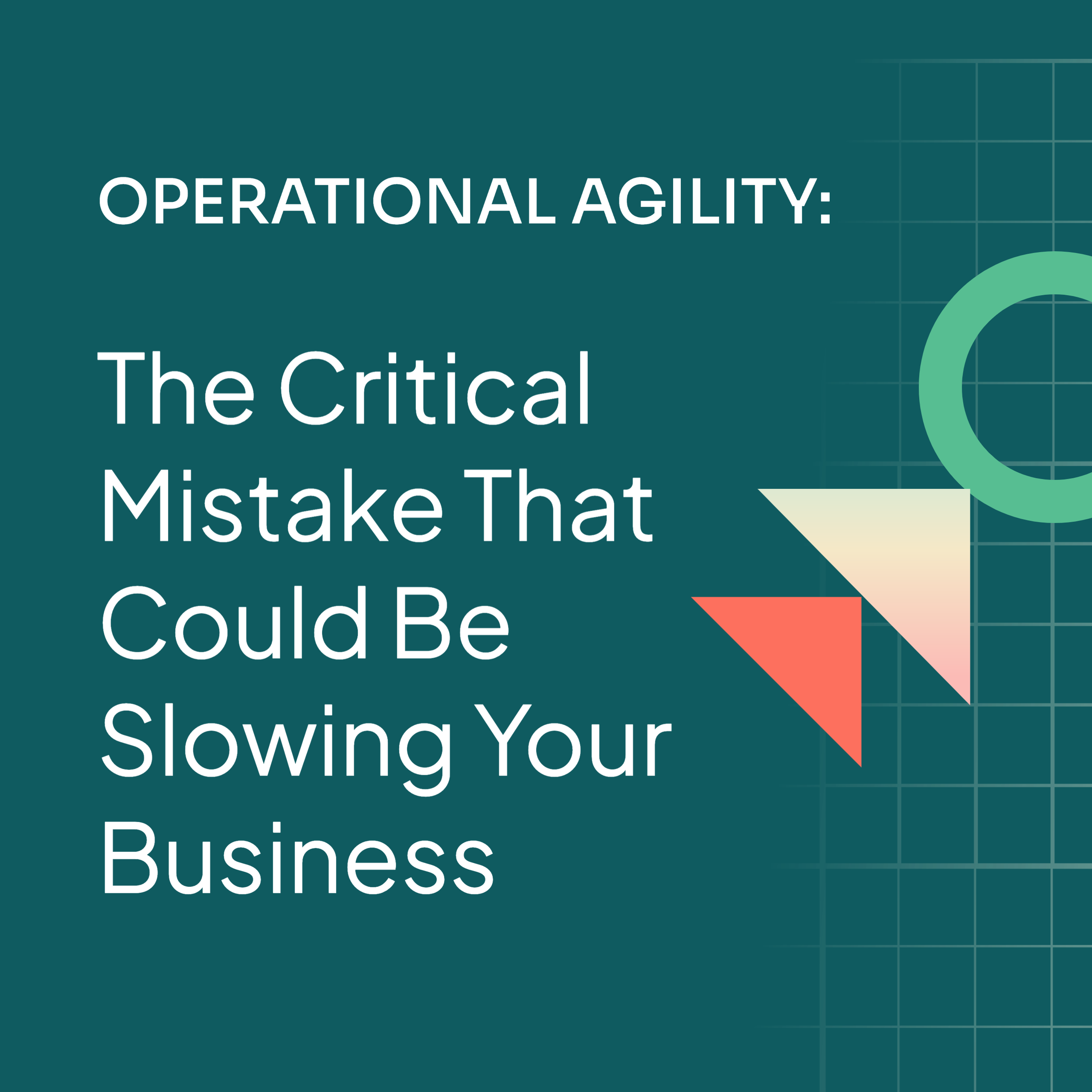The COVID-19 pandemic has sped up the adoption of key trends over the last decade: moves towards a better work/life balance, a digital transformation, an increase in “doing good” with emphasis on diversity, equity and inclusion, and corporate social responsibility… the list goes on.
It has also shifted the way businesses operate and plan. A recent study by IBM found that business agility and cash management are the top two priorities for Executives for the next two years (2020 – 2022).
As a finance leader, this makes a lot of sense – it’s imperative that all areas of a business be lean and nimble in the way they operate. The need for operational agility and effective cash management strategies is never more important than when conditions are uncertain – and the last two years have been nothing if not uncertain.
But, what does ‘agility’ really mean for a business?
What is business agility?
Aaron de Smet, a Principal and organizational design specialist at McKinsey defines agility as “the ability of an organization to renew itself, adapt, change quickly, and succeed in a rapidly changing, ambiguous, turbulent environment.”
We always hear about the importance of having an agile engineering team – one that’s able to quickly iterate, test, gather feedback, and repeat that process often.
But engineering isn’t the only function that should be agile. Have you ever thought about how differently your operations could run if your marketing function were viewed in the same light?
Business agility is the ability to pivot and react quickly to sudden changes. An example of agility in customer service can be seen in how a team is able to react to unforeseen spikes in demand

When your business is agile, you’re able to absorb the increase in demand with very little shock to your operations.
Why is it important to be agile?
If 2020 and 2021 have taught business leaders anything, it’s that the future is unknowable. We can’t possibly predict what will happen, so we must expect that something will and it is the responsibility of the corporate stewards to be prepared for anything.
While it’s still too early to know which companies are the big winners and losers from the pandemic, one thing is clear: those that were able to adapt quickly – offer their customers new ways to shop and pick up their items, transition to a remote-only workforce model with limited impact on the customer experience, and make these rapid changes while keeping their employees feeling valued, engaged, and secure – were able to get a leg up on their competition and can capitalize on that customer goodwill.
In short, to be caught flat-footed and unable to react with haste and efficiency is to be left behind.
The key pillars to organizational agility.
It’s clear that it’s important to take a nimble and proactive approach to business operations. For executives, there are 3 key areas in the operating model that determine how agile an organization will be: structure, process, and people.
It’s clear that it’s important to take a nimble and proactive approach to business operations. For executives, there are 3 key areas in the operating model that determine how agile an organization will be: structure, process, and people.

Structure
Structure includes the way an organization is set up and the hierarchy therein, but it also includes the way decision making is handled. For a business to be able to adapt and react quickly, it must embrace decentralized decision-making.
The key idea behind decentralized decision making is giving authority and responsibility to those who know best — since they’re closer to stakeholders and have relevant information available to them. In order for this approach to be successful, the handoff and mandate for on-the-ground decision making must be clear and well-articulated; attempts to implement an approach like this without explicitly making it clear to the entire organization will fail.
The benefit, however, of taking this approach is massive. Organizations that adopt an agile operating model make decisions 5-10x faster than those that are crippled with bureaucracy.
Processes
Processes are the activities that, when you string them together in a particular way, add value. One of the ways business leaders can impact the development of processes in their business is to set the framework for how decisions along that process are made.
Executives should identify the key metrics in a process and make sure all the different functions, business units, or geographies that are touching that decision or activity share the same metrics and targets. This helps immensely with collaboration across business silos or verticals.
I write this knowing that it’s a simple thing to say; it’s not an easy thing to do.
The issue is overcoming the walls of silos where functions are “siloed” off and have very little insight into what other departments are doing. Moreover, the metrics each function tracks and reports on typically only fall within that silo which only allows them to see a sliver of how the overall process is performing.
To avoid running into this narrow view of outcomes, the key is to identify the critical, value-adding activities and decisions—end-to-end, all the way to the customer— and then line up decision processes and separate them from the management hierarchy.
Let’s look at the customer order process at an e-commerce company as an example. Their marketing department is likely tracking website metrics like site visitors and conversion rate; the customer support team may be monitoring CSAT from chats made by users on the site; the supply chain team is likely watching the percentage of items in-stock and average estimated time to delivery.
While these are important metrics, surely, they individually do not get at the center of that stage in the customer journey: the customer’s NPS or overall satisfaction score. Focusing on the sub-layer of metrics rather than true key performance indicators (KPIs) can cause a business to not see shifts in the outside world until it’s too late.
People
The workforce is how a business gets done and it is also both the hardest and easiest thing to change.
There are few things that take a longer time to cultivate and change than the culture of a business. Culture takes a long time to build and also takes a long time to change. Ask any strong people leader and they’ll tell you that building a healthy culture requires a lot of thought.
While this makes building a strong, healthy culture a unique challenge, it also often means an incredible payoff when done right.
When you see companies that are very agile, they typically have something very special about the people who work there and the culture that they’ve built. These key competencies and capabilities are sources of distinctiveness and often provide a competitive business advantage.
So, how is this done? It begins with business leaders ingraining the question “is this core to what we do?” into the culture of the business. If organizations can become maniacally focused on only spending internal resources on things that are core to what they do, they will inherently become better at performing those activities and will become more agile in the process.
I believe embracing this ‘what is core?’ approach to staffing and putting it into practice is the single biggest low-hanging fruit business leaders can make.
Those businesses that have a ‘we don’t outsource’ or ‘only FTEs can deliver quality output’ mentality and rely only on internal hires are in a constant state of being overstaffed or understaffed. After all, how can a business be reactive when it takes months to recruit, hire, and train new team members or weeks of expense to offboard those that aren’t good fits?
As a finance leader, I cringe just thinking about how much cash is being tied up with the salaries and overhead for these relatively fixed expenses.
How to staff your business to achieve unparalleled agility.
What I’m suggesting here is a better, more agile approach to staffing: modernized outsourcing.
The modern approach to outsourcing is underpinned by flexible contracts that enable businesses to make changes after brief periods (i.e. after 60 days vs. 2 years in the traditional approach), giving them the flexibility to rapidly measure, optimize, and continuously improve.
It allows businesses to get meaningful results from business activities, not just performing activities. Furthermore, it leaves the business open to using flexible labor or other businesses to assist with the non-core activities. By having these relationships established and contracts already signed, organizations can more effectively resource during times of change.
When you outsource the modern way, you’re able to leverage the power of multiple partners to help your business so that you’re able to react quickly if something happens to you or one of your other partners. This means that if one leg of your operations goes down you have a network of trusted partners ready to pick up the missing piece until it becomes operational again.
By using multiple vendors, you’re able to react more quickly and scale faster – even intraday – creating overall better experiences for your employees all the way to your customers.
So what does this really look like?
The future of staffing.
When you consider a modern staffing model that includes outsourcing partners, your team structure might look different (in some cases, much different) than it does today.
Typically this means a small(er) internal team plus a portfolio of trusted partners who are trained up on your business and can easily step in to help with the workload and flex up during spikes in volume.
This staffing model highlights your internal team as a center of excellence, placing strategic focus on business strategy, customer journey mapping, escalations, and overall process improvements, while your external outsourced partners become responsible for the day-to-day tactics.
This model provides many benefits, like freeing up internal resources to really focus on the future of the business and core value differentiation, rather than spend a bulk of their time on task execution.
It also has positive implications on cash expenditure.

A CFO or finance leader will love the lower fixed headcount expenses, increased operational flexibility, and, if outsourcing partners are variably compensated, overall costs will be truly aligned to volume (and revenue).
Inside our operations: staffing for the unknowns of the future
Here at ArenaCX, we pride ourselves on practicing what we preach – because we know it works! We are, and have always been, laser-focused on what is truly ‘core’ to our business – and only those items are hired internally. We believe so strongly in a modernized staffing model that we use it ourselves, and we’re helping more and more businesses move toward this model every day.
Our impressive network of over 50 (and growing!) carefully vetted BPO partners are able to do almost anything in any vertical. Need sales reps to grow your business? We have partners who can provide end-to-end sales management or skilled SDRs trained in selling products like yours. Need customer service in various languages to support customers across the globe? We’ve got you covered.
From data entry, to bookkeeping, to outsourced CFOs, skilled outsourcing partners are available to help you achieve the business agility that will help you use your cash more efficiently while baking resiliency into your operations.
Next time the unexpected happens, you won’t have to wonder if your business can survive – you’ll be leading the pack.
Interested in learning more about how ArenaCX can help you with the right partners to achieve business agility?
Related Articles
Want more? Here are some other blog posts, topics and articles you might be interested in.












